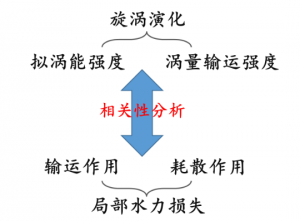CONTENTS
SPECIAL COLUMN ON THE 5th CMHL SYMPOSIUM 2022 (GUEST EDITOR DE-CHENG WAN)
Liutex based new fluid kinematics
Chaoqun Liu, Yifei Yu, Yi-sheng Gao(355)
Lattice Boltzmann simulations for multiple tidal turbines using actuator line model
Seiya Watanabe, Changhong Hu(372)
Numerical investigation on the effects of current headings on vortex induced motions of a semi-submersible
Wei-wen Zhao, Zhi-yuan Wei, De-cheng Wan(382)
On systematic development of FSI solvers in the context of particle methods
Abbas Khayyer, Hitoshi Gotoh, Yuma Shimizu(395)
On the comparison of particle regeneration technique and volume adaptive scheme in the compressible flow based on smoothed particle hydrodynamics
Ming-Kang Li, Shuai Zhang, Yu-Xiang Peng, A-Man Zhang(408)
Assessment of ship maneuvering simulation with different propeller models
Ganbo Deng, Patrick Queutey, Jeroen Wackers, Michel Visonneau, Emmanuel Guilmineau, Alban Leroyer(422)
ARTICLES
Modeling tail bubble dynamics during the launch of an underwater vehicle using the boundary element method
Shao-hua Cheng, Xiao-bo Quan, Sai Zhang, Tian-yuan Zhang, Shuai Li(434)
Numerical investigation of the influence of vortex generator on propeller cavitation and hull pressure fluctuation by DDES
Yun Long, Han-qiao Han, Bin Ji, Xin-ping Long(444)
A high-precision hydrodynamic model coupled with the hydrological habitat suitability model to reveal estuarine vegetation distribution
Qiao-feng Ma, Shu-xiu Liang, Zhao-chen Sun, Wen-hao Hou, Xin-yue Hu, Rui-jin Zhang(451)
Impact loads generated by tandem cavitation bubble on solid wall
Nyo Me Thet Naing, Jaehyun Park, Seung-Ho Hyun, Rho-Taek Jung(467)
Preliminary control of the air entrainment in bow wave based on the Liutex force method
Yi-ding Hu, Jian-wei Wu, De-cheng Wan, Guo Wang, Yi-qian Wang(483)
Numerical simulations of FPSO with sloshing tanks in a random freak waves
Yuan Zhuang, Guo Wang, De-cheng Wan, Jian-wei Wu(491)
Effects of cavitation on vortex-induced vibration of a flexible circular cylinder simulated by fluid-structure interaction method
Zhi-jian Xiao, Shi-hao Yang, Cao Yu, Zhen Zhang, Lei Sun, Jiang Lai, Yan-ping Huang(499)
Effect of Stokes number on energy modulation of the fluid in turbulent particle-laden channel flows
Zhi-feng Wu, Jian-zhao Wu, Bo-fu Wang, Zhi-ming Lu(510)
Influence of pump noise on the health of fish in a large pumping station
Fan Zhang, Lu-feng Zhu, Xiao-tao Shi, Ke Chen, Desmond Appiah, Shou-qi Yuan, Jin-feng Zhang(522)
Editorial Message(532)


 引用格式:Zhou, Z., Xu, Z., Wang, S. et al. Wall-modeled large-eddy simulation of noise generated by turbulence around an appended axisymmetric body of revolution. J Hydrodyn 34, 533–554 (2022).
引用格式:Zhou, Z., Xu, Z., Wang, S. et al. Wall-modeled large-eddy simulation of noise generated by turbulence around an appended axisymmetric body of revolution. J Hydrodyn 34, 533–554 (2022). 

 何国威,中国科学院力学研究所学术所长、学术委员会主任,中国科学院院士、研究员。长期从事湍流和计算流体力学的研究,提出的湍流时空关联的EA模型和大涡模拟的时空关联方法,被美国物理学会评价为对理解湍流的时空关联和发展时间精准的湍流模型做出了基本(fundamental)贡献。主要学术成果发表在《Annu. Rev. Fluid Mech.》,《J. Fluid Mech.》,《Phys. Rev. Fluids》,《J. Comput. Phys.》,《Phys. Rev. Lett.》等期刊上。曾获国家杰出青年科学基金,现任美国物理学会《Phys. Rev. Fluids》杂志副主编,中国力学学会《Acta Mech. Sin.》副主编,中国力学学会期刊《Theor. Appl. Mech. Lett.》主编。
何国威,中国科学院力学研究所学术所长、学术委员会主任,中国科学院院士、研究员。长期从事湍流和计算流体力学的研究,提出的湍流时空关联的EA模型和大涡模拟的时空关联方法,被美国物理学会评价为对理解湍流的时空关联和发展时间精准的湍流模型做出了基本(fundamental)贡献。主要学术成果发表在《Annu. Rev. Fluid Mech.》,《J. Fluid Mech.》,《Phys. Rev. Fluids》,《J. Comput. Phys.》,《Phys. Rev. Lett.》等期刊上。曾获国家杰出青年科学基金,现任美国物理学会《Phys. Rev. Fluids》杂志副主编,中国力学学会《Acta Mech. Sin.》副主编,中国力学学会期刊《Theor. Appl. Mech. Lett.》主编。
 周志腾,中国科学院力学研究所在读博士研究生。周志腾于2018年进入中国科学院力学研究所攻读博士学位,从事湍流噪声领域相关的科研工作,曾针对四极子声源穿出FW-H积分面导致的虚假噪声问题,利用格林函数的渐近展开,提出了一种四极子噪声修正模型。该模型克服了传统模型在部分马赫数下计算结果发散的问题,并成功应用在钝体绕流的远场噪声计算当中。相关成果已发表于《AIAA J.》,《Theor. App. Mech. Lett.》等期刊。
周志腾,中国科学院力学研究所在读博士研究生。周志腾于2018年进入中国科学院力学研究所攻读博士学位,从事湍流噪声领域相关的科研工作,曾针对四极子声源穿出FW-H积分面导致的虚假噪声问题,利用格林函数的渐近展开,提出了一种四极子噪声修正模型。该模型克服了传统模型在部分马赫数下计算结果发散的问题,并成功应用在钝体绕流的远场噪声计算当中。相关成果已发表于《AIAA J.》,《Theor. App. Mech. Lett.》等期刊。

 图2 水泵水轮机泵工况关键流域局部水力损失分布与旋涡演化特性分布对比
图2 水泵水轮机泵工况关键流域局部水力损失分布与旋涡演化特性分布对比 图3 水泵水轮机泵工况关键流域内水力损失与旋涡演化相关性分析
图3 水泵水轮机泵工况关键流域内水力损失与旋涡演化相关性分析
 李德友,工学博士,青年拔尖教授,博士生导师,能源学院院长专项助理,流体机械及工程研究所副所长,担任中国电机工程学会风力与潮汐发电专业委员会委员、中国水力发电工程学会抽水蓄能专委会委员、SAC/TC175/WG2“水力机械振动”标准工作组成员、SCI期刊Journal of Hydrodynamics编委、中国水力发电工程学会抽水蓄能专委会委员、《排灌机械工程学报》青年编委、IAHR会员等20余项职务,围绕双碳目标,面向国家专项,从事抽水蓄能机组及航空航天特种流体机械流动机理及流动控制策略研究,先后获2021年中国动力工程学会青年科技奖、2020年黑龙江省自然科学一等奖(排名2)、中国产学研合作创新与促进奖二等奖(排名3);入选2021年秋哈工大青年拔尖人才选聘计划-拔尖教授、2020年黑龙江省博士后青年英才计划、2018年秋哈工大青年拔尖人才选聘计划-拔尖副教授,主持国家自然科学基金面上项目、青年项目、中国博士后科学基金特别资助、十三五装备预研领域基金子课题等30余项;在Renewable & Sustainable Energy Reviews、Energy Conversion and Management、Journal of Cleaner Production、Renewable Energy、Physics of Fluids、AIAA Journal、Journal of Hydraulic Research、ASME Journal of Fluids Engineering等杂志上发表学术论文75篇,其中一作SCI论文35篇,通讯12篇(ESI高被引论文3篇,Top期刊19篇),授权/受理专利15项,软件著作10项。担任国家精品资源共享课、国家精品课程《工程流体力学》主讲教师,负责和参与教学项目10余项,发表教学论文10篇。指导学生获全国能源动力类优秀本科毕业设计论文、全国大学生节能减排竞赛一等奖等40余项奖励和荣誉。担任国家自然科学基金、教育部学位论文通讯评审专家。
李德友,工学博士,青年拔尖教授,博士生导师,能源学院院长专项助理,流体机械及工程研究所副所长,担任中国电机工程学会风力与潮汐发电专业委员会委员、中国水力发电工程学会抽水蓄能专委会委员、SAC/TC175/WG2“水力机械振动”标准工作组成员、SCI期刊Journal of Hydrodynamics编委、中国水力发电工程学会抽水蓄能专委会委员、《排灌机械工程学报》青年编委、IAHR会员等20余项职务,围绕双碳目标,面向国家专项,从事抽水蓄能机组及航空航天特种流体机械流动机理及流动控制策略研究,先后获2021年中国动力工程学会青年科技奖、2020年黑龙江省自然科学一等奖(排名2)、中国产学研合作创新与促进奖二等奖(排名3);入选2021年秋哈工大青年拔尖人才选聘计划-拔尖教授、2020年黑龙江省博士后青年英才计划、2018年秋哈工大青年拔尖人才选聘计划-拔尖副教授,主持国家自然科学基金面上项目、青年项目、中国博士后科学基金特别资助、十三五装备预研领域基金子课题等30余项;在Renewable & Sustainable Energy Reviews、Energy Conversion and Management、Journal of Cleaner Production、Renewable Energy、Physics of Fluids、AIAA Journal、Journal of Hydraulic Research、ASME Journal of Fluids Engineering等杂志上发表学术论文75篇,其中一作SCI论文35篇,通讯12篇(ESI高被引论文3篇,Top期刊19篇),授权/受理专利15项,软件著作10项。担任国家精品资源共享课、国家精品课程《工程流体力学》主讲教师,负责和参与教学项目10余项,发表教学论文10篇。指导学生获全国能源动力类优秀本科毕业设计论文、全国大学生节能减排竞赛一等奖等40余项奖励和荣誉。担任国家自然科学基金、教育部学位论文通讯评审专家。